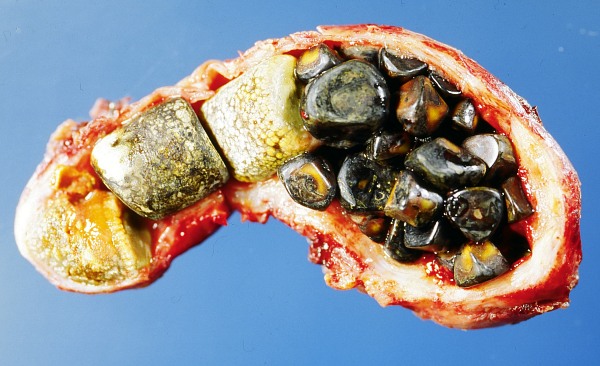Gallstone Disease
Gallstone disease, also known as cholelithiasis or choledocholithiasis, refers to the formation of stones within the gallbladder or bile ducts from precipitated bile components. These stones can lead to significant medical conditions, especially when they obstruct the biliary system.
Signs & Symptoms
Most people with gallstones are asymptomatic. However, symptomatic gallstones can cause intense cramp-like visceral pain in the right upper abdomen known as biliary colic or gallbladder attack. This pain is often accompanied by nausea and vomiting, and it may radiate to the tip of the scapula, known as "Collin's sign". Symptomatic gallstones can also cause fever, referred pain between the shoulder blades, and jaundice if bilirubin leaks into the bloodstream. Gallbladder attacks frequently occur after heavy meals, particularly in the evening or at night.
Other Complications
Complications from gallstones include cholecystitis (inflammation of the gallbladder), pancreatitis (inflammation of the pancreas), obstructive jaundice, cholangitis (infection of the bile ducts), and rarely, gallbladder cancer. Severe cases can lead to gallstone ileus, an obstruction caused by a gallstone eroding into the bowel.
Risk Factors
Factors increasing the risk of gallstones include female gender, age over 40, obesity, diabetes, rapid weight loss, pregnancy, and certain ethnicities such as Native Americans. Nutritional risk factors include a diet low in fibre, high in simple carbohydrates, and low in essential nutrients like folate, magnesium, and vitamin C. Prolonged use of proton pump inhibitors, certain medications (e.g., statins and fibrates), and conditions like Gilbert syndrome and celiac disease also increase the risk.
Pathophysiology and Composition
Gallstones form when bile contains excessive cholesterol and insufficient bile salts. They are classified based on their composition into cholesterol stones, pigment stones, and mixed stones.
- Cholesterol Stones: Light yellow to dark green or brown, and composed of at least 80% cholesterol by weight.
- Pigment Stones: Small, dark stones primarily composed of bilirubin and calcium salts.
- Mixed Stones: Contain 20-80% cholesterol along with calcium compounds, and arise secondary to biliary tract infections.
Images




Diagnosis
Diagnosis is typically confirmed by abdominal ultrasound, which detects gallstones and associated complications. Other imaging techniques include ERCP and MRCP. Blood tests may reveal complications.
Images

Treatment
Lithotripsy
Extracorporeal shock wave lithotripsy (ESWL) is a non-invasive method using high-energy sound waves to disintegrate gallstones. Side effects include biliary pancreatitis and liver haematoma.
Surgical
Cholecystectomy, or gallbladder removal, is the most effective treatment with a 99% success rate in eliminating recurrence. It can be performed via open surgery or laparoscopically. Laparoscopic cholecystectomy is preferred due to shorter recovery times.
Medical
Medications like ursodeoxycholic acid (UDCA) and chenodeoxycholic acid (CDCA) can dissolve small cholesterol stones. UDCA can also prevent gallstone formation during weight loss.
Images


Use in Traditional Medicine
Gallstones, particularly from old dairy cows, are valued in traditional Chinese medicine as antipyretics and antidotes. These stones are termed calculus bovis or niu-huang.
Self-assessment MCQs (single best answer)
Which term is synonymous with gallstone disease?
What is the primary symptom of symptomatic gallstones?
Which of the following is NOT a risk factor for gallstone formation?
Which imaging technique is commonly used to diagnose gallstones?
What type of gallstone is primarily composed of bilirubin and calcium salts?
What is the preferred surgical treatment for gallstone disease?
Which symptom is associated with a gallbladder attack and may radiate to the tip of the scapula?
Which medication can be used to dissolve small cholesterol stones?
What is a potential complication of gallstones that involves inflammation of the pancreas?
In traditional Chinese medicine, what are gallstones from old dairy cows used as?
Dentaljuce
Dentaljuce provides Enhanced Continuing Professional Development (CPD) with GDC-approved Certificates for dental professionals worldwide.
Founded in 2009 by the award-winning Masters team from the School of Dentistry at the University of Birmingham, Dentaljuce has established itself as the leading platform for online CPD.
With over 100 high-quality online courses available for a single annual membership fee, Dentaljuce offers comprehensive e-learning designed for busy dental professionals.
The courses cover a complete range of topics, from clinical skills to patient communication, and are suitable for dentists, nurses, hygienists, therapists, students, and practice managers.
Dentaljuce features Dr. Aiden, a dentally trained AI-powered personal tutor available 24/7 to assist with queries and provide guidance through complex topics, enhancing the learning experience.
Check out our range of courses, or sign up now!


